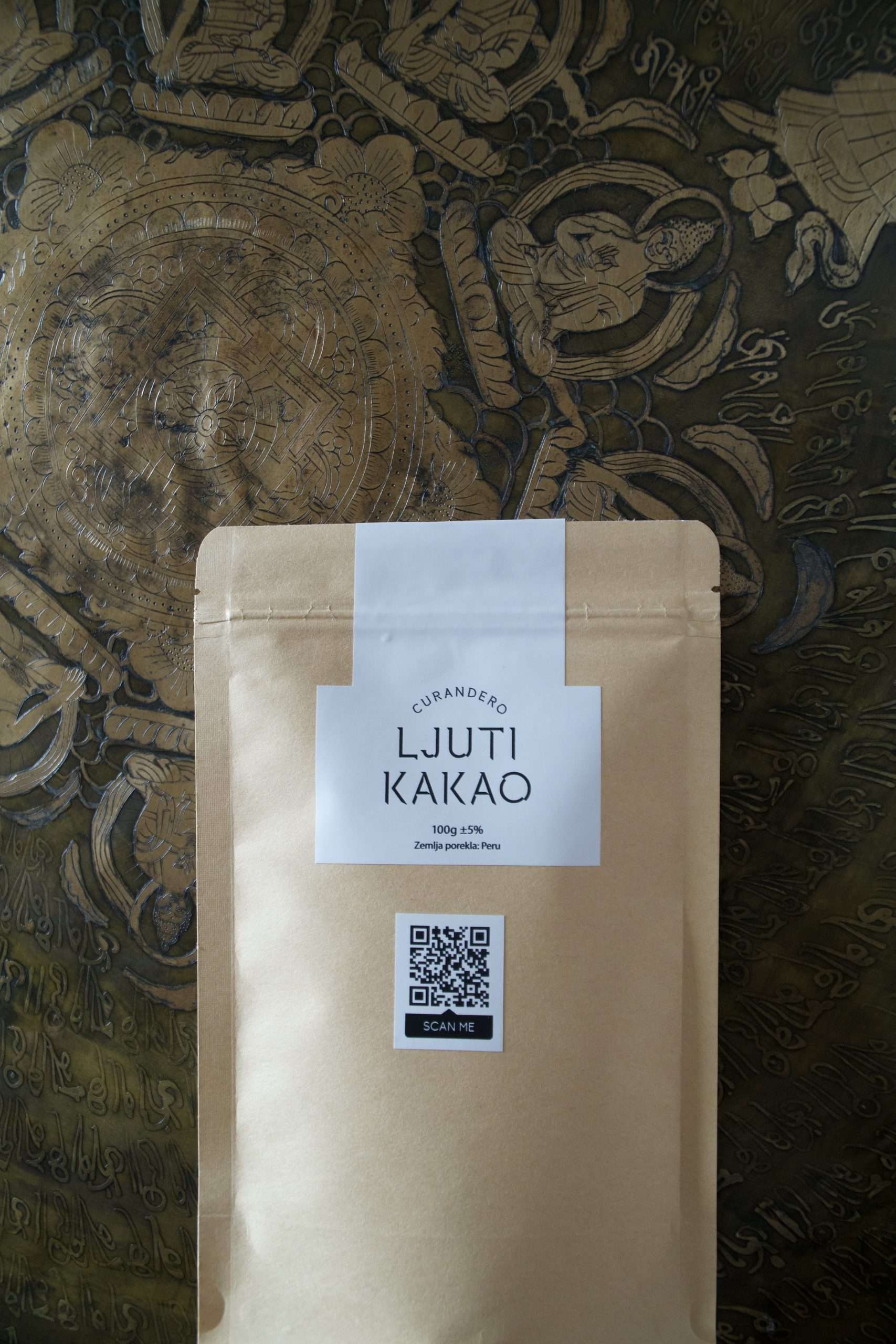Name of product: Ljuti kakao(Angry Cacao)
Ingredients: Cacao Raw Organic, Cardamon, Cinnamon, Himalayan Salt, all peppers of the world (White, Black, Green, India long, Pink, Sechuan)
Latin names: Theobroma cacao “Criollo Cacao”,Juniperus, Elettaria cardamomum,
Origin: Peru
Producing: @Curandero_shop
Organic, Raw powder
Cacao contains several minerals including calcium, copper, magnesium, phosphorus, potassium, sodium and zinc. All of these minerals are found in greater quantities in cacao than either cacao butter or cacao liquor. Cacao solids also contain 230 mg of caffeine and 2057 mg of theobromine per 100g.
The cacao effect refers to the bioactive compounds found in cacao products. These compounds include flavanols, procyanidins and epicatechin. Collectively, these molecules are called Cacao extract. Though these molecules are not unique to cacao. The compound epicatechin, for example, is also found in prunes. Procyanidin B2 is found in Grape Seed Extract and Pycnogenol. The cacao extract contains a particularly high level of epicatechin, compared to other plant products.
Cacao extract is a bitter mixture with a chocolate taste, made up of xanthine molecules (theobromine and Caffeine ) and procyanidins. Supplementing cacao extract may provide cardiovascular and cognitive benefits through improved blood flow and antioxidant effects.
Supplementation with dark chocolate or cocoa extract is worth a look. Unlike conventional high-dose single-antioxidant supplements such as vitamin C, E, etc., the antioxidant activity of flavonols such as epicatechin found in dark chocolate seems to do all that antioxidant supplements were originally promised to do, without negatively affecting endogenous ROS-signaling pathways.
Eating dark chocolate (50 – 85% cocoa), baker’s chocolate and semisweet chocolate provides a low dose of epicatechin and results in the same effects as cacao extract This is about 200 calories of chocolate. The more cacao chocolate contains, by weight, the less is needed to achieve the same epicatechin dose. White and milk chocolate do not contain enough catechins to provide the health benefits associated with dark chocolate.
Studies show that 5-26g of dark chocolate contains 65-1,095mg of flavanols. The standard dose for cacao flavanols is 500 – 1,000mg a day, taken with meals. Supplementing cacao extract can be replaced by dark chocolate consumption. Cacao extract is a safe supplement that promotes circulation and effective energy production. It has great potential long-term benefits.
Name of ingredient : (Wild Juniper)Juniper berries
Latin names: Juniperus
Origin: Serbia
About:
Juniper is short to a medium-height tree that grows wild in some parts of Europe, North America, and Asia. There are many varieties of juniper, but Juniperus communis is the most common in North America.
People use juniper berry to make medicine. Medicinal preparations include the extract of juniper berry and the essential oil of juniper berry. Don’t confuse juniper berry oil with cade oil distilled from juniper wood (Juniperus oxycedrus).
Juniper is used for digestion problems including upset stomach, intestinal gas (flatulence), heartburn, bloating, and loss of appetite, as well as gastrointestinal (GI) infections and intestinal worms. It is also used for urinary tract infections (UTIs) and kidney and bladder stones. Other uses include treating snakebite, diabetes, and cancer.
Some people apply juniper directly to the skin for wounds and pain in joints and muscles. The essential oil of juniper is inhaled to treat bronchitis and numb pain.
In foods, the juniper berry is often used as a condiment and a flavouring ingredient in gin and bitter preparations. The extract and essential oil are used as flavouring ingredients in foods and beverages.
In manufacturing, juniper oil is used as a fragrance in soaps and cosmetics.
Juniper extract and juniper oil are used in cosmetics including lipstick, foundation, hair conditioners, bath oils, bubble baths, eye shadow, and many other products.
A juniper berry is the female seed cone produced by various species of junipers. It is not a true berry but a cone with unusually fleshy and merged scales, which gives it a berry-like appearance. The cones from a handful of species, especially Juniperus communis, are used as a spice, particularly in European cuisine.
Health benefits -Juniper berries or extract of the plant have traditionally been used as a diuretic, anti-arthritis, anti-diabetes, antiseptic, and the treatment of gastrointestinal and autoimmune disorders.
Name of ingredient: Cardamon
Latin names:
Origin: India
About:
Cardamom (/ˈkɑːrdəməm/), sometimes cardamon or cardamom,[1] is a spice made from the seeds of several plants in the genera Elettaria and Amomum in the family Zingiberaceae. Both genera are native to the Indian subcontinent and Indonesia. They are recognized by their small seed pods: triangular in cross-section and spindle-shaped, with a thin, papery outer shell and small, black seeds; Elettaria pods are light green and smaller, while Amomum pods are larger and dark brown.
Species used for cardamom are native throughout tropical and subtropical Asia. The first references to cardamom are found in Sumer and the Ayurvedic literature of India.[2] Nowadays it is also cultivated in Guatemala, Malaysia, and Tanzania.[3] The German coffee planter Oscar Majus Klöffer introduced Indian cardamom to cultivation in Guatemala before World War I; by 2000, that country had become the biggest producer and exporter of cardamom in the world, followed by India.[4]
Name of ingredient: Cinnamon
Latin names:
Origin:
About:
Cinnamon is a spice that is made from the inner bark of trees scientifically known as Cinnamomum. It has been used as an ingredient throughout history, dating back as far as Ancient Egypt. It used to be rare and valuable and was regarded as a gift fit for kings
Benefits:
Antioxidants protect your body from oxidative damage caused by free radicals. Cinnamon is loaded with powerful antioxidants, such as polyphenols. In a study that compared the antioxidant activity of 26 spices, cinnamon wound up as the clear winner, even outranking “superfoods” like garlic and oregano. It is so powerful that cinnamon can be used as a natural food preservative. Inflammation is incredibly important. It helps your body fight infections and repair tissue damage. However, inflammation can become a problem when it’s chronic and directed against your body’s tissues. Cinnamon may be useful in this regard. Studies show that this spice and its antioxidants have potent anti-inflammatory properties. Cinnamon has been linked to a reduced risk of heart disease, the world’s most common cause of premature death. In people with type 2 diabetes, 1 gram or about half a teaspoon of cinnamon per day has been shown to have beneficial effects on blood markers. It reduces levels of total cholesterol, “bad” LDL cholesterol and triglycerides, while “good” HDL cholesterol remains stable More recently, a big review study concluded that a cinnamon dose of just 120 mg per day can have these effects. In this study, cinnamon also increased “good” HDL cholesterol levels. In animal studies, cinnamon has been shown to reduce blood pressure. Cinnamon Can Improve Sensitivity to The Hormone Insulin. Cinnamon Lowers Blood Sugar Levels and Has a Powerful Anti-Diabetic EffectCinnamon May Have Beneficial Effects on Neurodegenerative DiseasesCinnamon May Protect Against CancerCinnamon Helps Fight Bacterial and Fungal InfectionsCinnamon May Help Fight the HIV Virus
Name of ingredient: Himalayan salt
Latin names:
Origin: Pakistan
About:
Himalayan salt is rock salt (halite) mined from the Punjab region of Pakistan. The salt, which often has a pinkish tint due to trace minerals, is primarily used as a food additive to replace refined table salt but is also used for cooking and food presentation, decorative lamps and spa treatments. The product is often promoted with groundless claims that it has health benefits.
Himalayan salt crystals
Himalayan salt is table salt. Analysis of a range of Khewra salt samples showed them to be between 96% and 99% sodium chloride, with varying amounts of trace minerals such as calcium, iron, zinc, chromium, magnesium, and sulfate, all at safe levels below 1%.[1][9][10][11] Some salts mined in Pakistan are not suitable for food or industrial use without purification due to impurities.[1] Some salt crystals from this region have an off-white to transparent colour, while the trace minerals in some veins of salt give it a pink, reddish, or beet-red colour.[12][13]
Nutritionally, Himalayan salt is similar to common table salt,[11][14] except concerning the essential mineral iodine. The commercial table salt in many countries is supplemented with iodine, and this has significantly reduced disorders of iodine deficiency.[15] Himalayan salt lacks these beneficial effects of iodine supplementation.[16][17]
Name of ingredient: 7 types of Pepper (White, Black, Green, India long, Pink, Sechuan)
Latin names:
Origin: WORLD
About:
Pepper is one of the most commonly used spices worldwide. It’s made by grinding peppercorns, which are dried berries from the vine Piper nigrum. It has a sharp and mildly spicy flavour that goes well with many dishes. But pepper is more than just a kitchen staple. It has been deemed the “king of spices” and used in ancient Ayurvedic medicine for thousands of years due to its high concentration of potent, beneficial plant compounds.
Free radicals are unstable molecules that can damage your cells. Some free radicals are created naturally — such as when you exercise and digest food.
However, excessive free radicals can be formed with exposure to things like pollution, cigarette smoke, and sun rays (3Trusted Source).
Excess free radical damage may lead to major health problems. For example, it has been linked to inflammation, premature ageing, heart disease, and certain cancers (4Trusted Source, 5Trusted Source, 6Trusted Source).
Black pepper is rich in a plant compound called piperine, which test-tube studies have found to have potent antioxidant properties.
Studies suggest that a diet high in antioxidants may help prevent or delay the damaging effects of free radicals (1Trusted Source, 7Trusted Source).
Test-tube and rodent studies have observed that ground black pepper and piperine supplements may reduce free radical damage (8Trusted Source).
For instance, rats fed a high-fat diet plus either black pepper or a concentrated black pepper extract had significantly fewer markers of free radical damage in their cells after 10 weeks compared to rats fed a high-fat diet alone (9Trusted Source).
Chronic inflammation may be an underlying factor in many conditions, such as arthritis, heart disease, diabetes, and cancer (10Trusted Source, 11Trusted Source).
Many laboratory studies suggest that piperine — the main active compound in black pepper — may effectively fight inflammation (12Trusted Source).
For example, in studies in rats with arthritis, treatment with piperine resulted in less joint swelling and fewer blood markers of inflammation (13Trusted Source, 14Trusted Source).
In mouse studies, piperine suppressed inflammation in the airways caused by asthma and seasonal allergies (15Trusted Source, 16Trusted Source)
However, the anti-inflammatory effects of black pepper and piperine have not yet been studied extensively in people.
Piperine has been shown to improve brain function in animal studies.
In particular, it has demonstrated potential benefits for symptoms related to degenerative brain conditions like Alzheimer’s and Parkinson’s disease (17Trusted Source, 18Trusted Source).
For example, a study in rats with Alzheimer’s disease found that piperine improved memory, as the distribution of piperine enabled the rats to repeatedly run a maze more efficiently than rats not given the compound (19Trusted Source).
In another rodent study, piperine extract seemed to decrease the formation of amyloid plaques, which are dense clumps of damaging protein fragments in the brain that have been linked to Alzheimer’s disease (20Trusted Source, 21Trusted Source).
Yet, studies in humans are needed to confirm whether these effects are also seen outside animal studies.
Studies suggest that piperine may help improve blood sugar metabolism (22Trusted Source, 23Trusted Source, 24Trusted Source).
In one study, rats fed a black pepper extract had a smaller spike in blood sugar levels after consuming glucose compared to rats in the control group (25Trusted Source).
Additionally, 86 overweight people taking a supplement containing piperine and other compounds for 8 weeks experienced significant improvements in insulin sensitivity — a measure of how well the hormone insulin removes glucose from the bloodstream (26Trusted Source).
However, it’s unclear whether the same effects would occur with black pepper alone, as a combination of many active plant compounds was used in this study.
High blood cholesterol is associated with an increased risk of heart disease, which is the leading cause of death worldwide (27Trusted Source, 28Trusted Source).
Black pepper extract has been studied in animals for its potential to reduce cholesterol levels (29Trusted Source, 30Trusted Source, 31Trusted Source).
In one 42-day study, rats fed a high-fat diet and a black pepper extract had decreased blood cholesterol levels, including LDL (bad) cholesterol. The same effects were not seen in the control group (31Trusted Source).
Additionally, black pepper and piperine are believed to boost the absorption of dietary supplements that have potential cholesterol-lowering effects like turmeric and red yeast rice(32Trusted Source, 33Trusted Source).
For example, studies have shown that black pepper may increase the absorption of the active component of turmeric — curcumin — by up to 2,000% (34Trusted Source).
Still, more studies are needed to determine whether black pepper itself has significant cholesterol-lowering effects in humans.
Researchers hypothesize that the active compound in black pepper, piperine, may have cancer-fighting properties (35Trusted Source, 36Trusted Source).
Though no human trials have been performed, test-tube studies found that piperine slowed the replication of breast, prostate, and colon cancer cells and induced cancer cell death (37Trusted Source, 38Trusted Source, 39Trusted Source, 40Trusted Source).
Another test-tube study screened 55 compounds from spices and observed that piperine from black pepper was the most effective at enhancing the efficacy of traditional treatment for triple-negative breast cancer, the most aggressive cancer type (41Trusted Source).
What’s more, piperine has shown promising effects in laboratory studies for reversing multidrug resistance in cancer cells — an issue that interferes with the efficacy of chemotherapy treatment (42Trusted Source, 43Trusted Source).
Though these results are promising, more studies are needed to understand the potential cancer-fighting properties of black pepper and piperine.
pepper may benefit health in many other ways according to preliminary research:
- Boosts absorption of nutrients. Pepper may increase the absorption of essential nutrients like calcium and selenium, as well some beneficial plant compounds, such as those found in green tea and turmeric (1Trusted Source, 44Trusted Source).
- May promote gut health. The makeup of your gut bacteria has been linked to immune function, mood, chronic diseases, and more. Preliminary research suggests that black pepper may increase the good bacteria in your gut (1Trusted Source, 45Trusted Source).
- May offer pain relief. Though it has yet to be studied in humans, studies in rodents suggest that the piperine in black pepper may be a natural pain reliever (46Trusted Source, 47Trusted Source).
- May reduce appetite. In a small study, 16 adults reported reduced appetite after drinking a black-pepper-based beverage compared to flavored water. However, other studies did not show the same effects (48Trusted Source, 49Trusted Source).





Ema Gray –
Perfect combination of spices to boost the cacao flavor and effect!
I love it and I recommend it to anyone who likes a pinch of hot and spicy 🙂
TanjaM –
One of THE BEST cocoas I’ve ever tasted. It’s amazing even when baking with it. Such a unique combo with the spices inside.
Mirjana –
Ovo je moj omiljeni proizvod. Najlepši kakao ikada! Predivnih aroma, pravi balans egzotičnog, intezivnog a negujućeg istovremeno. Ne znam da li je lepši miris ili ukus. Hvalaaaa na ovoj magiji🙏🏻🙏🏻🙏🏻
prishamilica –
Odlična kombinacija začina i prelep kakao.
Otvra srce i dušu, koristim ga svako jutro u svojim smutijima.
Topla preporuka.
Dule (verified owner) –
Divna aroma i kvalitet. Volim da ga dodam u smuti ili kašu od voća. Daje punoću i bogatstvo ukusa.
belivetar (verified owner) –
Angry Cocoa is my first choice for a comforting and warming drink during the winter days. The addition of spices adds a delightful twist to traditional hot cocoa, creating a unique and flavorful experience that tastes like pure magic.